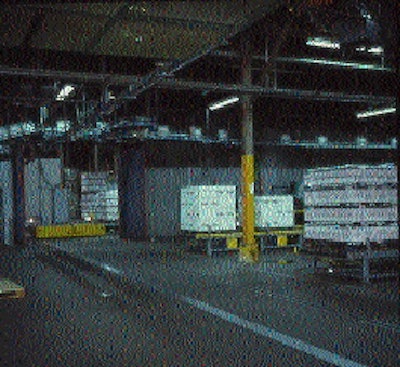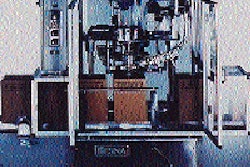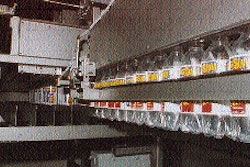A pair of automated transfer cars and two automatic pallet stacking systems from Kaufman Co. (Toledo, OH) has brought significant improvement to the Owens Brockway glass plant in Oakland. By performing the work formerly done by drivers in forklift trucks, the new equipment * allowed Owens to reduce the number of forklift drivers by two or three per shift, * helped reduce damage to cases caused by forklifts, and * limited the chance for injury due to collisions between fork lifts and people. Maintenance supervisor Ray Bettencourt has this to say about the improved outlook for safety: "If forklifts and people on foot occupy the same area, there's always a chance for an accident, no matter what precautions are taken. Now the forklifts can be kept on the outside perimeter, away from most of the foot trafic." Also from Kaufman are two automatic pallet stackers that complement the transfer vehicles. Before these stackers arrived, pallet stacking was a three-step operation. Fork lift drivers had to set one pallet down, lift a second pallet onto the first, and then lift the pair onto the turntable of the stretch wrapper. Now the operators aren't involved at all. The machines do it automatically. Not only does that free them to perform other needed tasks, it also reduces the number of opportunities for damage to a case by a misguided fork. Supplier to the wine industry Located as it is near Napa Valley and other prime wine-growing districts, the Oakland facility produces a lot of wine and champagne bottles. But in addition to these narrow-neck containers, it also cranks out plenty of wide-mouthed jars and bottles for foods and other products. Regardless of type, the containers that ultimately get handled by the automated transfer cars all move from one of three furnaces to cooling to case packing. Cases then travel on overhead conveyors to one of eight palletizers, all lined up in a straight row. It's at the full pallet discharge conveyors that the transfer cars come into play. In the past, two or three fork lift drivers were responsible for picking up full pallets from these conveyors and driving them to one of two stretchwrapping stations. Now the transfer cars do all the work. Palletizers one through four are served by one transfer car, which delivers pallets to a stretch wrap area at the north end of the building. Palletizers five through eight are served by the other transfer car, which takes its pallets to a stretch wrap area at the south end of the building. The total length of the path along which the cars travel is 282 feet, and each car covers roughly half that distance. A 2"-wide groove cut into the floor and lined with steel supports is what keeps each car on a straight path. Into this groove fit two steel shafts, one bolted to the front of a car and the other to the back. Mounted to each shaft is what Kaufman calls a "cam follower." Essentially it's a wheel that rotates freely around the shaft on bearings the way a roller skate wheel rotates on its axle. Without the cam follower, there would be too much drag as the shaft scraped against first one side and then the other side of the steel groove, and the drag would tax the motor heavily. PLC controls Propulsion is provided by an electric motor and a chain and sprocket drive. Signals governing the movement of the vehicles come from a PLC 520 supplied by Allen-Bradley (Milwaukee, WI). "Nearly every load leaving its palletizer has different needs," says Kaufman's Tom Monaghan. "Out of one palletizer a load may be 110 inches tall, so it doesn't need to be double stacked, though it does need a top sheet before it gets stretch wrapped. But out of another palletizer may come a short load that needs to have a second pallet stacked on top of it, so you may not want a top sheet, but you do want the pallet stacker to know what to do as the load nears the palletizer. All this information is conveyed automatically through the PLC and its complementary software." Despite the variety of information exchanged and the number of options that can be exercised, the path of the cars is unchanged. With each cycle, a car leaves the stretch wrap area, goes to one of four powered roller discharge conveyors leading from one of four palletizers, receives one or two pallets, and then returns to the stretch wrapping area. At this point, the powered rollers on the transfer car are activated to send the pallet toward the pallet stacker. If this particular pallet must be stacked atop another, the system software tells the forks of the pallet stacker to lift the pallet and hold it in place. When the next pallet reaches the pallet stacker, down comes the top pallet onto it and the forks withdraw. The stacked pallets then move on powered roller conveyors onto the stretch wrapper's platform. In cases where no stacking at all is involved, the pallet stacker is not activated and pallets roll straight into the stretch wrapper. One word Bettencourt chooses to describe the transfer cars is "relentless." But the units are also capable of sensing if something is in their path. This they accomplish by means of two "diffuse reflective photoelectric sensors," one in front and one in back. Supplied by Cutler-Hammer (Milwaukee, WI), these infrared light-based sensors send a signal to the transfer vehicle to slow down and, ultimately, to stop if need be. According to Bettencourt, the use of two transfer cars was not a given early in the planning stages. "We did consider using one transfer car, but that would have meant locking ourselves into a situation where if one vehicle goes down, all eight palletizing lines are at a standstill. Speedwise, too, you'd be using that one car so much more that the service and maintenance factor would only be that much higher. Not only that, but our speeds get higher every year, and it won't be too long before one car simply wouldn't handle eight palletizing lines. "Right now we're very comfortable with the volumes we need to contend with. Even if something does go down in one of the cars or in the stretch wrap area, we can line up nine or ten loads on each palletizer discharge conveyor and then restart the cars and within 25 minutes or so we'll have those loads cleared out. That's pretty quick. And it's smooth, too. You don't see a lot of jerking or starting and stopping." Considering the scope of the installation-two cars and their trackwork, two pallet stackers, and one new palletizer-the investment was no doubt sizable. But payback, says Bettencourt, will come in less than two years.






















